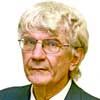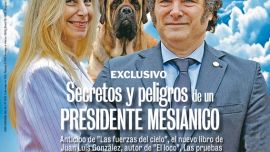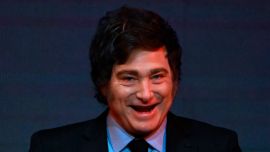This column on the last of Argentina’s 20 ministries should perhaps begin with an explanation of its headline, which is in no way intended to imply that the new minister is incompetent (while not affirming that he is especially competent either) – it rather reflects the current historical low point in the Interior Ministry’s influence.
One of the quintet composing the very first Cabinet back in 1854, the Interior Ministry has since occupied a pivotal dual role until fairly recent times – both as a top cop along the lines of the British Home Secretary or European interior ministers and as a chief political operator, almost a quasi-premier with a special focus on supervising federal-provincial relations. Virtually no minister successfully performed both these roles, either wearing one hat or the other (with the political one usually considered the more attractive). But the Cabinet chief emerging from the constitutional reform of 1994 ended this political supremacy even if he (never a she until now despite 15 different chiefs) failed to evolve into a quasi-premier as intended, still serving to block any such aspirations for the Interior Ministry. The global rise of spin doctors around this time meanwhile displaced Interior from the engine room of political manipulation. Then in 2010 the creation of a Security Ministry removed the portfolio’s other main leg as top cop.
Yet from this low point the Ministry managed to stage a revival in the ensuing decade until now. The Once rail tragedy of 2012 led to then-interior minister Florencio Randazzo annexing Transport along with a generous budget to modernise the railway system, going from strength to strength to become Cristina Fernández de Kirchner’s heir-apparent – until he wasn’t, one of the few Peronist bigwigs still out in the wilderness and thus making the ruling coalition the Frente de (not quite) Todos.
Randazzo’s successor Rogelio Frigerio (minister throughout the 2015-2019 Mauricio Macri administration) boosted Interior on at least two levels. Firstly, since (let’s face it), as even many of his most fervent fans are forced to admit, Macri is simply not a politician – this enabled Frigerio to regain much of his ministry’s traditional political clout, especially in the area of negotiations with the mostly Peronist governors to avert Congress gridlock (with Cabinet Chief Marcos Peña an eternal campaign manager). Secondly, while losing Transport, Frigerio could expand the ministry by picking up public works (too hopelessly riddled with Kirchnerite corruption to continue as a ministry) and housing.
Today’s Interior Minister Eduardo Enrique “Wado” de Pedro, 43, enjoys none of the advantages of his two predecessors. Transport, Public Works and Housing are now all ministries on their own account while President Alberto Fernández is not only arguably Argentina’s most experienced political operator but also regards the nexus with provincial governors as very much his baby as a Peronist sector potentially easing his dependence on his Vice-President Fernández de Kirchner, who reportedly insisted on Wado as minister precisely in order to keep an eye on that nexus. In any case that front has lost its importance since the pandemic shattered provincial revenues and reduced the governors (unable to print money) to abject dependence. Keeping an extremely low profile even before quarantine, De Pedro has lost all visibility beyond fairly frequent appearances in protocol photographs of announcements made by others (a tendency to stammer, with no Lionel Logue/Geoffrey Rush as in the film The King’s Speech in sight to bail him out, does not help here) – no obvious way of knowing whether he is a power behind the throne working in stealth or just a nowhere man.
Yet De Pedro potentially walks tall as not only heading a historically important ministry but also as the senior representative of the Kirchnerite La Cámpora youth grouping (which he co-founded in 2006) in the Frente de Todos Cabinet. Like his Environment colleague and La La Cámpora comrade, Juan Cabandié, De Pedro is the child of missing parents although, unlike many such cases including Cabandié, he was never deceived as to his origins, being raised by his aunt rather than by some military couple. A University of Buenos Aires (UBA) law graduate with a postgraduate degree in public administration from Universidad San Andrés, his ascent to the Ministry was preceded by two terms as national deputy (interrupted only during the last 10 months of the Cristina Fernández de Kirchner presidency in 2015 when he was presidential chief-of-staff), representing the Victory Front caucus on the Magistrates Council since 2014 – Congress was the main training-ground for honing his political skills where he developed an image as the least abrasive of the La Cámpora leaders. He has mellowed considerably since his extreme youth when in 1997 he co-founded HIJOS – one of the more militant human rights groupings which specialised in often disruptive escrache ("exposure") protests.
Prior to Randazzo (2007-2015), there were no less than 109 interiors ministers since 1854, all of them male right up to the present – of these, five subsequently became president but all of them, except Ramón Castillo, were ministers in the 19th century. Most of the others found this portfolio to be the end rather than the launch of their careers because of its extreme political sensitivity – between 1868 and Aníbal Fernández under Néstor Kirchner (2003-2007), the ministry changed helm every 14 months on average and this turnover would accelerate sharply if the first Peronist Ángel Borlenghi (the longest-serving of them all from 1946 to 1955) and the minister of Radical Hipólito Yrigoyen, Ramón Gómez (1916-1922), are subtracted. Arturo Mor Roig was assassinated in 1974 by the Montoneros, 14 months after relinquishing the ministry. All prior to 2012 were designated simply Interior Minister, except for 15 months in 1954-1955 when the portfolio also covered Justice.
Today’s column rounds out the 20 ministries but does not quite end this series. When President Fernández identified his Cabinet last December 6, he also named a further dozen officials and it would be an error to rank the more important of these below the less important ministers, especially since some of them work much more closely with the President on a day-to-day basis within an administration which has not made a culture of Cabinet meetings – apart from a brief period between the summer holidays and quarantine. Over half of these officials are female with their announcement perhaps designed to correct a certain imbalance in the Cabinet itself, with only four women among the 20 ministers. These officials (who include a previous Interior minister, Gustavo Beliz, by the way) will be good for a couple more columns.



















Comments